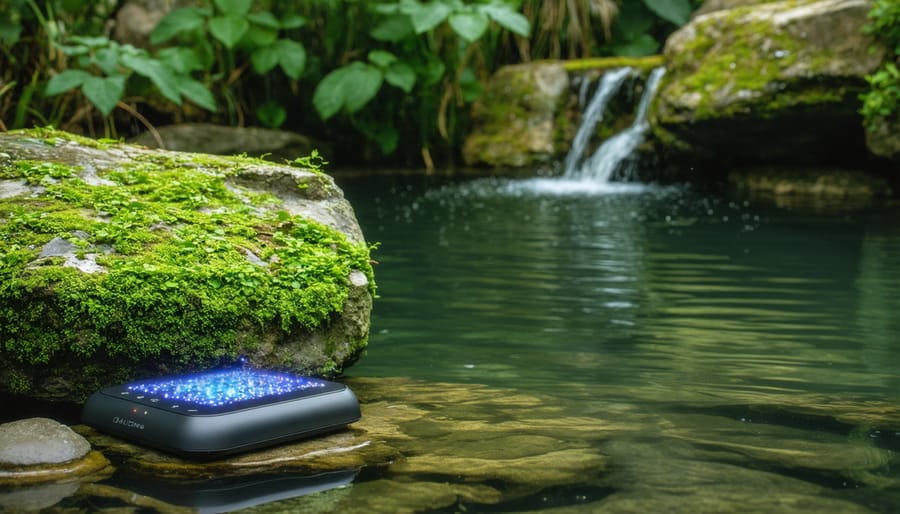
Revolutionizing Pond Wildlife Tracking: How Quantum Sensors Are Making Waves
Quantum sensors are revolutionizing biomedical diagnostics by detecting microscopic changes in biological systems with unprecedented precision. These cutting-edge devices harness the principles of quantum mechanics – particularly quantum superposition and entanglement – to measure subtle magnetic fields, electric potentials, and molecular interactions within living tissue. Recent breakthroughs have enabled the development of quantum magnetometers sensitive enough to map neural activity in real-time and quantum-based biosensors capable of detecting individual proteins and DNA molecules.
The integration of quantum sensing technology into medical devices promises earlier disease detection, more accurate diagnostics, and personalized treatment monitoring. From non-invasive brain imaging to rapid point-of-care testing, quantum sensors are opening new frontiers in healthcare. Their ability to operate at the atomic scale while maintaining room-temperature functionality makes them ideal for clinical applications.
This emerging field combines the latest advances in quantum physics, nanotechnology, and biomedical engineering to create tools that could transform everything from cancer screening to neurological monitoring. As quantum sensing technology continues to mature, it’s poised to enable a new generation of medical devices that are more sensitive, precise, and capable than ever before.
Understanding Quantum Sensors for Your Pond

What Makes Quantum Sensors Special?
Quantum sensors bring something truly special to the world of wildlife monitoring systems. Unlike traditional sensors, these amazing devices tap into the quirky behavior of tiny quantum particles to measure things with incredible precision. Think of them as super-sensitive detectors that can pick up the smallest changes in your pond’s environment.
What makes them really stand out is their ability to detect tiny magnetic fields, temperature changes, and even subtle movements that regular sensors might miss. For pond owners, this means you can track fish behavior, water quality changes, and ecosystem health with amazing accuracy. It’s like having a microscopic guardian watching over your pond 24/7!
These sensors are also great at working in challenging conditions. They can keep measuring accurately even when it’s cloudy, raining, or during temperature swings. Plus, they use very little power, so you won’t need to change batteries often. For pond enthusiasts, this means more reliable monitoring with less maintenance – exactly what we all want for our peaceful water gardens!
How They Work in Water
Quantum sensors operate in water through a fascinating interplay of quantum mechanics and biological processes. When submerged, these sensors detect minute changes in the magnetic fields generated by biological molecules, even in complex aqueous environments. The water molecules actually help stabilize the quantum states needed for measurement, contrary to what many might expect.
The sensors use nitrogen-vacancy centers – special atomic-scale defects that are extremely sensitive to changes in their environment. When biological molecules interact with these centers, they create distinct magnetic signatures that the sensors can detect. The surrounding water acts as a natural conductor, helping to carry these subtle signals to the sensor.
What makes these sensors particularly valuable for biomedical applications is their ability to maintain sensitivity even in fluid environments. They can detect individual proteins, monitor enzyme activity, and track cellular processes in real-time without being disturbed by the presence of water. This capability is crucial for applications like monitoring brain activity, tracking drug delivery, or studying protein interactions in their natural state.
Real Benefits for Your Pond Wildlife
Fish Health Monitoring
Quantum sensors are revolutionizing the way we approach monitoring pond health, particularly when it comes to keeping tabs on our finned friends. These innovative devices use quantum mechanics principles to detect subtle changes in fish behavior and health patterns that traditional sensors might miss.
By measuring microscopic variations in water chemistry and fish movement patterns, quantum sensors can alert pond owners to potential health issues before they become serious problems. The sensors track important indicators like swimming speed, feeding patterns, and stress levels through changes in the fish’s electrical signals and body temperature.
What makes these sensors particularly exciting for pond enthusiasts is their ability to work around the clock without disturbing the natural habitat. They can detect early signs of common fish diseases by monitoring changes in behavior that might be invisible to the naked eye. For example, if a fish starts swimming erratically or spending more time near the surface, the sensors can notify you immediately through your smartphone.
The technology also helps maintain optimal water conditions by continuously measuring oxygen levels, pH, and temperature with unprecedented accuracy. This means you can create the perfect environment for your fish to thrive, reducing stress and preventing illness before it starts. It’s like having a 24/7 fish health guardian watching over your pond!
Water Quality Benefits
Quantum sensors are revolutionizing how we monitor water quality in biomedical applications, offering unprecedented precision in detecting harmful contaminants and measuring crucial parameters. These advanced sensors can detect minute changes in pH levels, dissolved oxygen, and trace elements at the molecular level, making them invaluable for ensuring water safety in medical settings.
In laboratory environments, quantum sensors utilize the principles of quantum mechanics to identify specific molecules and compounds with remarkable accuracy. For instance, they can detect heavy metals, bacteria, and other harmful substances at concentrations as low as parts per trillion – a level of precision that traditional sensors simply cannot match.
What makes these sensors particularly valuable for biomedical applications is their ability to provide real-time, continuous monitoring without the need for chemical reagents or time-consuming laboratory analysis. This immediate feedback allows medical facilities to maintain optimal water quality for sensitive procedures, from dialysis treatments to pharmaceutical production.
The technology also excels in detecting biological contaminants that could compromise patient safety. By measuring quantum-mechanical properties of water molecules and their interactions with various substances, these sensors can quickly alert staff to the presence of dangerous pathogens or chemical imbalances before they become problematic.
Perhaps most impressively, quantum sensors can simultaneously monitor multiple parameters while maintaining their exceptional accuracy, making them a cost-effective and efficient solution for comprehensive water quality management in medical facilities.

Getting Started with Quantum Sensors
Choosing the Right System
When selecting quantum sensors for biomedical applications, several key factors must guide your decision-making process. First, consider the specific biological parameter you need to measure – whether it’s magnetic fields from neural activity, temperature variations in tissue, or molecular interactions at the cellular level. Each application demands different sensitivities and operating conditions.
The operating environment is crucial – some quantum sensors perform best in controlled laboratory settings, while others are designed for in vivo measurements. For clinical applications, prioritize sensors with biocompatibility certifications and minimal interference with biological processes. Size constraints are particularly important for implantable or wearable devices.
Your budget and technical expertise should also influence your choice. While some high-end quantum magnetometers offer exceptional precision, simpler nitrogen-vacancy (NV) center-based sensors might be more practical for routine diagnostic use. Consider the availability of supporting equipment and whether your facility can maintain the necessary operating conditions, such as temperature stability or magnetic shielding.
Data processing requirements vary significantly between systems. Some sensors integrate with existing medical imaging platforms, while others need specialized software and expertise. As smart pond technology evolves, look for sensors with user-friendly interfaces and reliable technical support to ensure successful implementation in your biomedical research or clinical practice.

Installation Tips
When installing quantum sensors for biomedical applications, proper setup is crucial for accurate measurements. Begin by identifying an appropriate location with minimal electromagnetic interference, ideally away from large metal objects and electronic equipment. The sensor should be mounted on a stable, vibration-free surface, preferably using non-magnetic mounting materials.
Temperature control is essential – maintain a consistent room temperature between 20-25°C (68-77°F) for optimal performance. Install appropriate shielding if necessary, particularly in environments with multiple electronic devices. Consider using mu-metal shields for particularly sensitive measurements.
Regular calibration is vital for maintaining accuracy. Establish a calibration schedule based on manufacturer recommendations, typically every 3-6 months. Keep detailed records of calibration data and any drift patterns observed.
For maintenance, clean the sensor components using only manufacturer-approved methods and materials. Avoid using harsh chemicals or abrasive materials that could damage sensitive components. Regular visual inspections can help identify potential issues before they affect measurements.
When connecting to monitoring systems, use high-quality shielded cables to minimize signal interference. Ensure all connections are secure and properly grounded. Consider implementing a backup power supply to prevent data loss during power fluctuations.
Remember to maintain environmental controls, including humidity levels between 30-50% and proper air filtration to prevent dust accumulation on sensitive components.
As we look to the future of pond management, quantum sensors represent a groundbreaking advancement that promises to revolutionize how we care for our aquatic ecosystems. These innovative devices offer unprecedented accuracy in monitoring water quality, temperature fluctuations, and wildlife activity, making them invaluable tools for both hobbyists and professional pond keepers.
The benefits of incorporating quantum sensors into pond management are truly remarkable. They provide real-time data with exceptional precision, allowing for immediate response to potential issues before they become serious problems. This proactive approach not only saves time and resources but also ensures better health outcomes for fish and plant life.
Looking ahead, we can expect to see even more exciting developments in quantum sensor technology. Manufacturers are working on making these devices more affordable and user-friendly, bringing professional-grade monitoring capabilities within reach of everyday pond enthusiasts. Future iterations may include improved wireless connectivity, longer battery life, and enhanced mobile integration for seamless monitoring from anywhere.
The potential applications seem limitless – from automated feeding systems that respond to fish behavior patterns to smart filtration systems that adjust based on real-time water quality measurements. As this technology continues to evolve, it will become an increasingly essential part of responsible pond management, helping us create and maintain healthier, more vibrant aquatic environments for generations to come.
